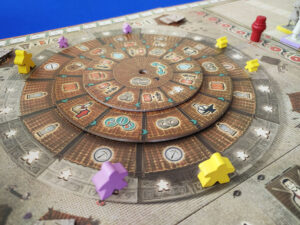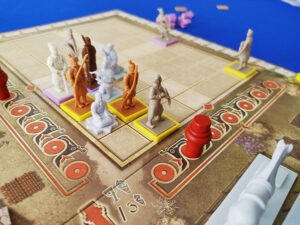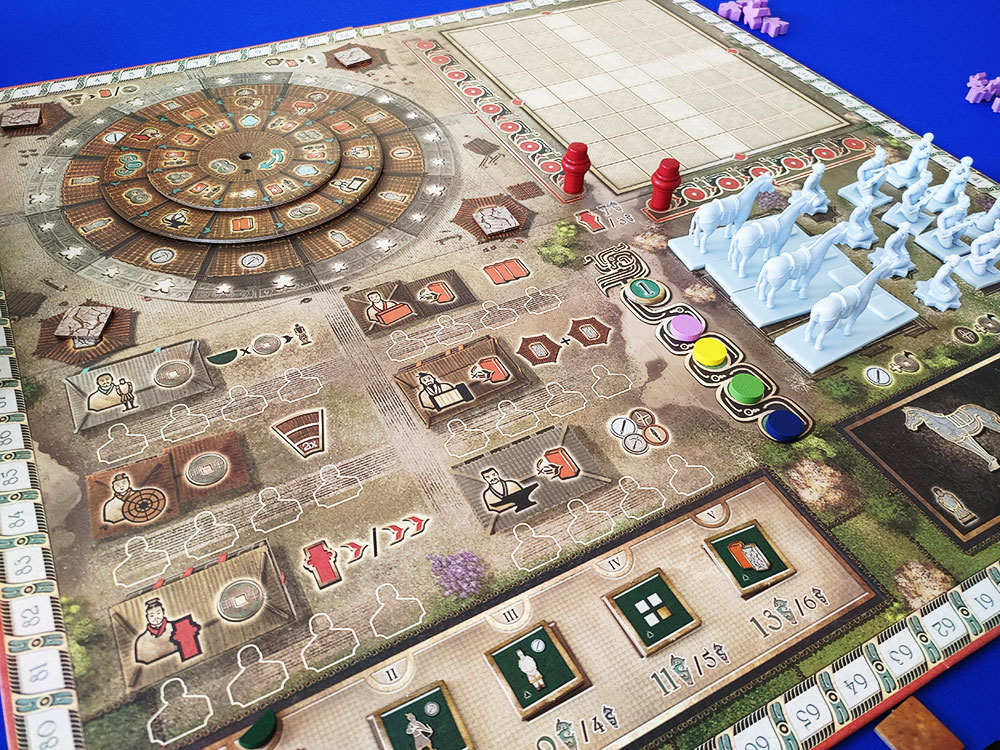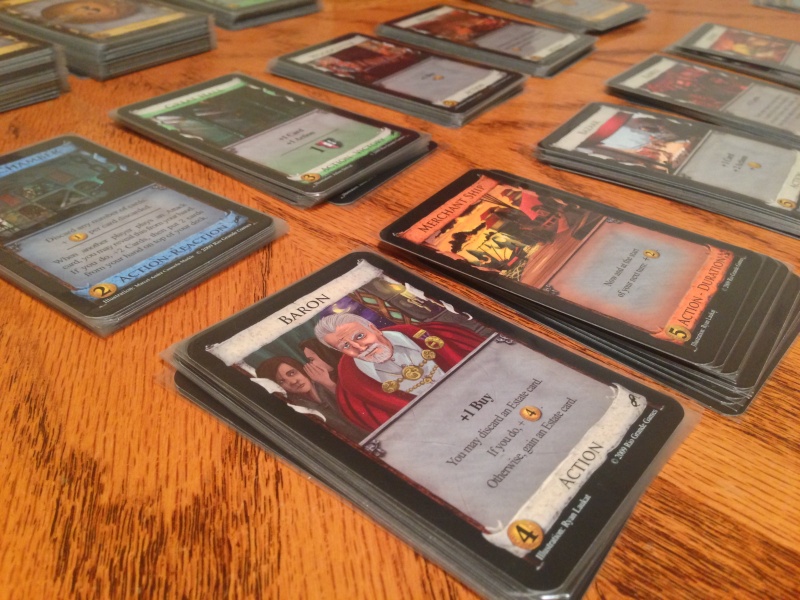 Join me, Dear Readers, as we walk down memory lane. It was August in the great American city of Indianapolis. There I was, strolling the hallowed halls of GenCon. From across the aisle, a game caught my eye. It had miniatures, so my initial instinct was to run away. But as I inched closer, it became clear that the minis were only there to trick people into thinking the game was something it wasn’t. The game was a Euro! I had to have it. I needed to play it and review it and tell the whole world about it.
Join me, Dear Readers, as we walk down memory lane. It was August in the great American city of Indianapolis. There I was, strolling the hallowed halls of GenCon. From across the aisle, a game caught my eye. It had miniatures, so my initial instinct was to run away. But as I inched closer, it became clear that the minis were only there to trick people into thinking the game was something it wasn’t. The game was a Euro! I had to have it. I needed to play it and review it and tell the whole world about it.
Later that night I told everyone about the game at the nightly gathering of the Board Game Quest staff. (There’s a bunch of GenCon rituals we engage in. Some involve summoning Cthulhu, but not all. We also have snacks!) It turned out that Andrew Smith had already grabbed a review copy of the game I had had in my sights. My opportunity had slipped away. All hope was lost. Desperate, I grabbed Andrew by his BGQ-branded shirt collar and said breathlessly, the tears barely staying locked within the edges of my eyelids, “Can I please have that copy of Terracotta Army to review?”
“Why not,” he said, removing my hands calmly. “Get a hold of yourself.”
Success! The game was mine! And now I’ve played it! And now I’m going to tell you about it!
Gameplay Overview:
Terracotta Army is a worker placement and action selection game with a good deal of area majority thrown in. It’s designed by Przemyslaw Fornal and Adam Kwapinski and takes about two hours to play. In the game, players will be sending out their workers (Craftsmen and, potentially later, Artisans) to trigger a succession of actions that will let them build the titular army of statues in a shared mausoleum.
At the start of the game, players start with tiny Craftsmen. These function the same as their larger counterparts except that they can’t block spaces like the Artisans eventually will. The game round consists of players placing these workers around a triple-stacked wheel and then taking the three actions, in order, that correspond to this placement. There are a lot of actions that players can take in the game, so I won’t go over each of them here. But a few of the main ones are building a terracotta warrior (more on that later), gathering resources such as clay and coins, achieving mastery in a discipline, and building statues.

As I mentioned earlier, the main way to score points is to build warriors in the mausoleum. For the most part, this is a standard Euro-game endeavor of swapping resources for the desired warrior. Want the gray-colored Archer warrior? Great. Use the required amount of wet clay, grab the most-valuable statue from the game’s nifty storage tray, and throw it onto the grid. What complicates this decision is not only the intrinsic value of that warrior type at the time of its build, but also if additionally using its associated reward is possible or worthwhile.
You see, to even have this as an option available to them, players will need to ensure that they have the corresponding weapon token “readied” before building the associated warrior type. Now, I’m not entirely sure why having, say, a crossbow in one’s workshop makes building an Archer statue more point-worthy, but the game tells me that’s the case so I’m just going with it. If players choose to use these associated weapons at the time the warrior is placed into the mausoleum, then they will get a unique bonus. Archers, for instance, score bonus points for being orthogonally far away from another statue, while Guards, as an example, have the added ability to move other statues in the mausoleum, which can come in handy if there’s a round-end bonus for statue positioning.

Another “building” action type is the capacity for players to erect one of four neutral statues in the mausoleum. These will never be controlled by a specific player, but through careful placement, they can be more beneficial to one person than their opponents.
Once a player has taken their three actions—or skipped them to grab an extra resource—it’s the next player’s turn and so on until the round concludes. At the end of the round, players will score either Domination—having the most of something—or Presence—simply existing somewhere (that’s deep, man)—for being in the same row or column as the mausoleum’s Inspector pawns, which move at various points in the game. There are also end-round bonuses that score similarly for different things and then some resource upkeep like drying clay one’s clay thereby making it unusable until it’s moistened by taking an action in the next round.
After five rounds, the game ends and there’s one more scoring phase (which I’ll talk about later) before the points are tallied and a “Best in Mausoleum” trophy is awarded to the player with the best clay army.

Game Experience:
Right from the get-go, this game has a ton of options for players to chew on. Each action spot has three actions players can take, so knowing where to start is something of a chore. Players also have the option of paying two coins in order to spin the two inner wheels before putting a worker down, which increases the action combinations on offer every turn quite a bit. Now, none of the actions are complicated at all and by the midway point of the game, everything will be moving smoothly from that aspect but there is something of an information curve.
One thing that helps with this overload is that every round has a clear explanation of what things will give you points at the end. If a specific quadrant in the mausoleum is going to be scoring at the end of the round, well then that’s where everyone should be cramming their stuff. The game is going to give points to whoever has the most money at the round’s end? Well then go chase down coins however you can.

The way these various activities interact is also quite enjoyable. Building this soldier gives you this many points and triggers that action, which helps my next turn so I can take that action and so on. The whole game is that sort of thing. And it’s really successful in letting players chain together actions to make themselves feel super smart. It also helps that everyone scores a boatload of points in this game; I’ve never played a game of this in which there has been a player finish with fewer than 200 points. For better or worse, this provides a solid dopamine hit on a turn-by-turn basis.
Overall, I’d say the game also scales pretty well. Even at two players, the area control portion of the mausoleum works basically the same although it is easier to pull off impressive combos because there’s inherently more space to maneuver and grab actions on the wheel. One area where the game doesn’t excel in terms of scalability, however, is its length.

Terracotta Army is long. Like… remarkably long. It isn’t overly complicated and it also isn’t the longest game out there, but given that you’re often taking the same types of actions every turn the game feels like it overstays its welcome. And then you realize you’re only in the middle of round three of five. My first play was a teaching play and after that things did move more quickly, but I do feel that there’s some tweaking that could have been made to make the game move faster. Perhaps give all players one less worker every round? Or I’d even say it’s arguable players could chop off an entire round of play and not miss much, although that might be a terracotta bridge too terracotta far.
Compounding the length issues is that there’s a scoring quirk during final scoring that involves the grouping of the types of soldiers in the mausoleum. Basically, being near the same type of statue is good and you have to go through everything that’s placed and look for groups of two or more and then give a very small number of points to those players. It’s fiddly and accounts for so few points—especially given how much everyone scores during the game itself—that it’s something I’m seriously considering house-ruling out of existence. (And I can’t stand house-ruling stuff. Just ask BGQ writer Brandon Bryson.)
Final Thoughts:
Quibbles with game length and that one bizarre scoring thing at the end, I am very pleased with Terracotta Army. It’s easy to understand and rewards players on every turn for doing basic things. It also looks pretty neat on the table as the game progresses (despite some iffy component quality). I’m not sure what kind of legs this design will ultimately have, but it’s one of the rare modern games that feels complete right out of the box and isn’t screaming for an obvious expansion.
Final score: 4 Stars. A strong Euro design that uses worker placement as its primary method in making a simplified area majority game.
 Hits:
Hits:
• Linking actions is a big win
• Relatively easy to play (once you get the hang of it)
• Unique combination of worker placement and area majority
• Good table presence
Misses:
• Takes way too long to play
• Mediocre component quality despite the good appearance
• Endgame scoring takes a while (and is strange to boot)






















